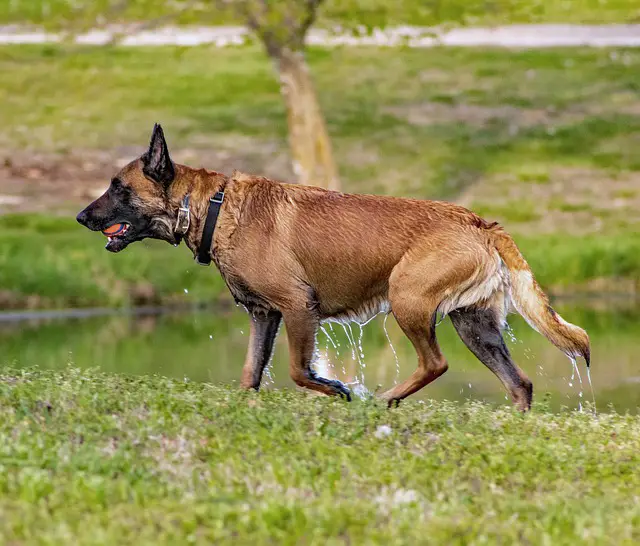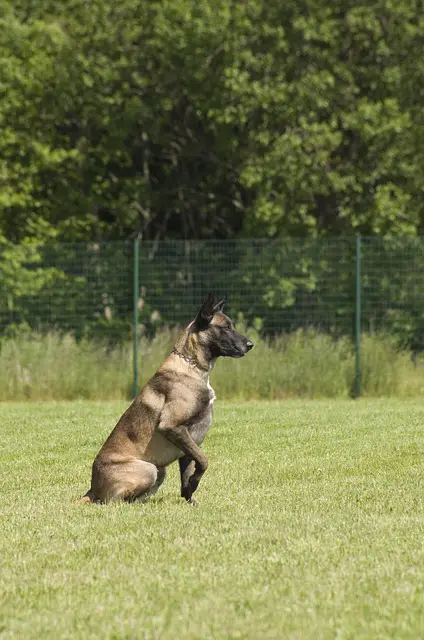The Belgian Malinois is one of four different Belgian shepherd varieties that also include the Belgian Tervuren, the Laekenois, and the Groenendael, otherwise known as the Belgian sheepdog.
All four of these dogs were originally bred in Belgium for herding different types of livestock and the Malinois hails from the village of Malinois, Belgium.
The Malinois is an active, energetic, and strong breed and is also recognized as one of the most hard-working.
This dog is not as popular in the United States as it is at home in Belgium, but has begun to make a breakthrough recently in the States.
Rather than using its look-a-like breed, the German shepherd, police, the Secret Service, and the military have begun partnering with the Belgian Malinois.
In fact, a Belgian Malinois was a military teammate that was responsible for capturing Osama Bin Laden.
The highly intelligent Malinois with its very physical attributes is generally a relatively healthy breed.
Being such an active dogs, suffering from a disease that could rob them of their mobility would be a shame.
Unfortunately, Belgian Malinois are prone to hip dysplasia, just as some other large-boned breeds like the German shepherd are.
In this post, you will receive information about hip dysplasia, Belgian Malinois hip dysplasia symptoms, and Belgian Malinois hip dysplasia treatment.
To check your Belgian Malinois health status or their DNA, please visit the Embark vet website for all the help you may need.

For your dog’s vitamin supplement, food, toys, or other dogs product please visit the Sundays for dogs website.
What Is Hip Dysplasia in Dogs?
Hip dysplasia is a condition that pet owners don’t like to think about and it can develop in any breed of dog, but larger dogs like the Belgian Malinois are one of them.
Hip dysplasia is also commonly found in German shepherds, Great Danes, Labrador retrievers, St. Bernards, mastiffs, and Rottweilers.
In a normal hip joint, the ball fits into the socket just right and makes for smooth movement.
When hip dysplasia occurs, the joint does not properly develop, resulting in a partially dislocated hip.
Instead of moving fluidly, the joint grinds and rubs causing pain and eventual deterioration of the joint leading to loss of mobility.

What is The Cause of Hip Dysplasia in Dogs?
The condition of hip dysplasia is the most common disorder of the skeletal system diagnosed in dogs.
Hip dysplasia is a mostly genetic disease and hereditary in nature. Dogs with hip dysplasia or linked genetically to it should not be bred.
Environmental factors can also play a role in exacerbating and progression of the condition. Hip dysplasia can occur in one hip or bilaterally, in both hips.
Since it is more common in larger breeds, dogs that grow too quickly can put greater strain on joints.
Nutrition also can tip the scale negatively if your Malinois is not getting a proper healthy diet, being overfed, causing speedy growth and weight gain, or too little exercise.
Your Belgian Malinois needs high-quality food to ensure that muscles and joints are growing steadily.
Overfeeding and too little exercise can cause weight gain and strain and stress on joints. Also, puppies need exercise but overdoing it when their bones are still forming can make hip dysplasia worsen quickly, damage growth plates, and cause sprains.
Belgian Malinois Hip Dysplasia Symptoms
Hopefully, your Belgian Malinois will never develop hip dysplasia but below are some Belgian Malinois hip dysplasia symptoms. Hip dysplasia can begin at a young age. Listed below are symptoms.
- Stiffness Your pup is slow to get moving.
- difficulty rising Your Malinois has trouble getting up from a seated or prone position.
- Difficulty Sitting If your Belgian Malinois is healthy, they will have no problem sitting comfortably on their haunches. In hip dysplasia, your pup may splay or slouch to the side. Often, they favor one side over the other.
- Reluctance to Play If your pup has always enjoyed the play and gotten excited when you’ve pulled out a ball but now shows no interest, it could be hip dysplasia or another medical issue.
- Difficulty Jumping or Running Although jumping on people should always be discouraged, if your pup has run and jumped for frisbee or ball in the past and is now reluctant to do so, something is amiss.
- Lameness will occur and is another word for limping or hobbling with difficulty walking. Your pup may also, at times, “bunny hop.”
- Decreased Activity A normally energetic and active Belgian Malinois becomes increasingly inactive.
- Pain Pain in the hip area when touched or with movement. Your pup may also exhibit a decreasing range of motion in the hips.
- Muscle Loss Your Belgian may lose muscle mass in the thighs from inactivity but their shoulders may bulk up and become more muscular from relying more on these muscles.
- Grating joints You may even hear grating or clicking noises from the rubbing of bone and joints.
- Restlessness Your pup may become increasingly restless and unable to get comfortable.
Diagnosing Hip Dysplasia
If you suspect that your Belgian Malinois has hip dysplasia, make an appointment with their veterinarian, so treatment can begin promptly to avoid progression, pain, immobility, and suffering.
Your veterinarian has probably been checking your pup’s hips from puppyhood, but there are tests to diagnose hip dysplasia.
- X-ray Hip dysplasia can be diagnosed with an x-ray or in medical terminology, a radiograph. Your Belgian Malinois will be sedated to get accurate pictures, allowing them to be limp and malleable. The x-ray technician will need to rotate the hips for different angles. If your pup is in pain this would be a big challenge without sedation.
- MRI or CT scan Hip dysplasia can be discovered with diagnostic testing like an MRI or a CT scan but x-rays can most often pick up hip dysplasia and those special scans are much more costly. Question your veterinarian if they forgo the x-ray and go straight for the scans.
- Ortolani Test This test is only used in young pups and is performed by placing the dog on its back to see if hip joints pop out and in by rotating the hips.
Belgian Malinois Hip Dysplasia Treatment
Listed below are treatments for hip dysplasia.
- Comfortable Environment
Create an environment for your pup that is dog-friendly by using dog steps or a ramp for easier access to your car or around your home.
A dog bed or mattress that is supportive yet cradles tender joints is a must. In colder weather, heated dog beds are warm and soothing.
- Exercise
Yes; exercise can help, but low-impact, such as walking, without concentrating on too much distance or speed is acceptable.
This will actually help with pain and stiffness. It will help keep excess weight off, as well, which would only aggravate the condition more.
Try to walk your pup on softer surfaces other than concrete. Swimming is also a fabulous way of incorporating exercise that takes the pressure off of bones and joints. This can be a very enjoyable pastime if your Malinois likes to swim.
- Physical therapy
Physical therapy is also offered for dogs with hydrotherapy, gentle movement exercises, and even massage.
- pain medication
Pain medications can also be used as directed by your veterinarian and are usually non-steroidal anti-inflammatories or NSAIDs
- joint supplements
Supplements either as pills or in diet, as some dog foods include these, can help heal cartilage and minimize inflammation.
Often, glucosamine and chondroitin are two familiar supplements used and are taken by humans as well.
- acupuncture
Yes; there is acupuncture for dogs, which has been proven very effective for pain in both canines and humans alike.
- surgery
There are various surgical procedures that will help with hip dysplasia depending on the severity and age of your Belgian Malinois.
Total hip replacement surgery is an option in cases that are severe. Your pup’s quality of life can increase dramatically if all goes well with surgery.
Belgian Malinois are prone to hip dysplasia, but as stated in the post, there is some prevention you can do.
Using a reputable breeder that screens breeding dogs for hip dysplasia as well as other genetic and hereditary diseases. is number one on the list to ensure you get the healthiest Belgian as possible.
Proper nutrition and exercise is another way to prevent, without over-exercising or over-taxing growing bones and joints when your Belgian is a puppy.
If you observe any of the symptoms, do not hesitate to have your pup checked out by their veterinarian.
Prompt treatment in a timely manner is necessary to slow the progression of hip dysplasia and for the well-being and comfort of your Belgian Malinois.
